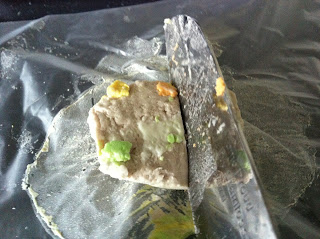LB: Final Experiment Procedure
Research Question: Does the process of gelatinisation cause the GBR to float?
Hypothesis: The higher the surface area to volume ratio, the faster the GBR floats in water.
Steps
1. Measure out 175g each of rice flour and water using a weighing scale, and mix until evenly distributed.
2. Take a small part and mix in green food colouring. Using the method outlined in this post, make a flat of 1 cm thickness.
.JPG) |
| I counted playing cards to make blocks of the correct height. |
3. Repeat step 2 4 times for 4 pieces of dough from 2-5 cm thickness, but with different colours of food colouring.
 |
| all the different colours of dough (fifth was a mix made from the scraps) |
4. Place all disks of dough onto plates, cover with cling wrap and place into a fridge to chill until the dough is hard and unyielding to the touch. This takes about two days. Then, take the disks out.
5. Letting the thickness of the disk be n, cut a cube with sides of n cm and a cuboid with sides of n by n/2 by 5/3n cm. For example, 1 cm thick disk would be cut into a 1 cm cube and a 1 by 0.5 by 1.7 cm cuboid. An exception is the 5cm cuboid, which will not be used as it does not fit into the displacement can.
.JPG) |
| After chilling, GRB cuts smoothly and does not stick to the knife |
5. Dust the GRB produced with cornflour.
 |
| Green 1 cm cube during dusting |
.JPG) |
from top to bottom, left to right: 5 and 3cm cubes, 3cm cuboid, 4 and
2cm cubes, 2cm cuboid, 4cm cuboid, 1cm cube and 1cm cuboid
6. Wrap the 3cm cube in cling wrap, gather the corners of the cling wrap and twist shut.
7. Fill a displacement can with water, and slowly submerge the wrapped GRB while using the 100ml measuring cylinder to catch the displaced water. Record the volume and repeat steps 6-7 for the 4cm cube.
8. Weigh and record the mass of each GRB.
Weighing the 4cm cube before cooking
9. Using a 250ml cylinder, pour 1250ml of water into a pot.* Put the pot on a hotplate set to 120°C and start the stopwatch. When the water has begun to boil, slowly drop all cuboid and the 1 cm cube GRB into the water by hand.
Inserting the 1cm cube
10. Stir continuously with the strainer and record the time it took for each GRB to float. Turn off the hotplate when all GRBs are floating.
Stirring with chopstick
All 5 GRBs in the second round are floating
11. Switch the hotplate's settings to "keep warm" (70°C), and repeat step 7 (directly slipping the GRBs into the displacement can without wrapping them). Use hot water taken from the pot to fill the can.
Weighing the 4cm cuboid
12. Use the strainer to individually transfer each GRB to the scale or displacement can, then back into the pot and complete these two steps as fast as possible, before the GRB cools down.
13. Repeat steps 9-12 for the 5 GRB left.
At the end of first round, with 4 cubes cooked and rest uncooked
*Increased due to increased size of GRB, can observe sinking/floating better
|

.JPG)

.JPG)
.JPG)






No comments:
Post a Comment